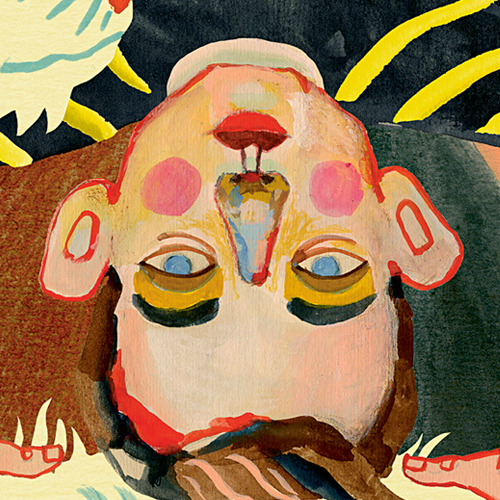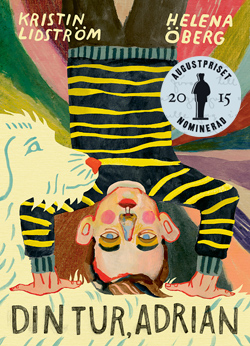< Back to posts
Kristin Lidström
Sweden

Kristin Lidström is an illustrator and book designer with a Master of Fine Arts from HDK, School of Design and Crafts at Gothenburg University. Since graduating, she's established herself as one of the most innovative illustrators and designers in Sweden, and she's received numerous accolades for her work.
In this post, Kristin talks about ‘Din tur, Adrian’ (Your turn, Adrian), a multidimensional graphic novel she co-created with Helena Öberg. This beautifully produced book is published by Mirando Bok, and received a nomination for The August Prize in Sweden.
Kristin: I received a request from the publishing house, Mirando Bok, asking if I was interested in co-creating and illustrating a book with dyslexia as the central theme. I said yes right away because reading, books, and storytelling is of great interest to me.
At the beginning, ‘Your turn, Adrian’ had a clear core. There was a theme with a main character, a dog and a possible dramaturgy, but no details. This was the task that the writer Helena Öberg and I took on together during the close process we came to share, from initial idea to the finished picturebook. Strenuous and time consuming work with numerous questions to answer or discard was the basis with which to reach a common goal. The recurring keyword in our working process was trust. Without trust, words and images could not emerge like they did in this case.
The story revolves around a boy called Adrian, who struggles with his vulnerability at school due to elusive syllables and fleeing lines. Thanks to a creative imagination and the ability to keep out the destructive surrounding world, he discovers a haven to go to when the surrounding world gets too brutal. The world of the circus arts becomes a mental salvation for him, and his interest in acrobatics can flourish. In somersaults and balance exercises, the body becomes a manageable asset and has a strength that is in sharp contrast with the insecurity he is overwhelmed by when faced with letters and reading.
The encounter with the giant wolfhound, Hejdi, is crucial to him. One day she's just there; she follows him like a shadow on his way home from yet another hard day at school.
The idea and composition of the front cover is from the thought of a person who wishes to hide their reading difficulties from the surrounding world, but at the same time reveals themselves when the book that is read from is held upside-down. It's a vulnerable situation. The person becomes easy prey for whoever ruthlessly wishes to take advantage of the situation. At the same time, the upside-down Adrian relates to the strength within the art of acrobatics. Yes, he's certainly upside-down, viewing the world from another perspective, but he's not falling. He stands firmly and gains power from the steadfast body of Hejdi the wolfhound.
The process:
“Where is the manuscript?” was my first thought when I received the initial draft from Helena. It was a synopsis consisting of episodes that lead the main character and the theme forward, rather than fixed dialogue and set pages. I thought I was going to receive a writer's deliberate and definite story in my hands, and then make suggestions for images to go with it. It took a while before I realised that I, as a visual artist, was actually getting to take part in creating the story together with Helena. We didn't know each other and had never worked together before. Trusting each other's competence was a condition from the start, in order for this method of work to be possible to carry out.
In my first sketches, the objective was to unearth Adrian's character. The publisher and Helena wanted the pencil to be the main form of expression, and also to let the visual narrative take the form of a graphic novel.
Helena mentioned in her draft that Adrian stood eye to eye with a dog, which was an important factor in the interpretation and search for the right kind of dog. The decision fell on the Irish Wolfhound, whose size gave the right proportions, but also characteristics regarding fur and prominent features such as legs and head. Anatomy not covered in layer upon layer of fur. The body was distinct.
We then tried to pin down the story, focusing on which parts were going to be related via image, and which ones via text. The storyboard is an effective means of communication and gives a quick visual survey, but without a complementary text document describing the action in each frame, we would not have gotten far.
In the construction of this, the red winter hat emerged as a symbol. It didn't exist in the draft, but became an object useful in portraying Adrian's vulnerability and retribution through different parts of the story. I got a picture in my head from the very beginning – of wanting to see threads of yarn come apart (like an association with how the body's own blood vessels break as it is beaten from the outside).
I saw how this image became the antipole of another image further on in the story, where the feeling is the exact opposite of the vulnerability in the schoolyard. In the subsequent picture, Adrian is safe and he runs his fingers through Hejdi's soft fur while reading. The fur does not break, like the yarn. It provides strength and courage.
As the storyboard emerged and provided a clearer framework for the outline of the story, Helena worked with a text that was to become a voice-over for the images. We adjusted the details and restructured some spreads until we were satisfied with the whole. At that stage I felt that we had reached our goal. What remained for me was the solitary work and craftsmanship in turning the quick-sketch ideas into originals on paper and screen.
‘Without Hejdi the heart grew empty’.
As soon as I read this, it became my favourite sentence in the book.
Illustrations © Kristin Lidström. Post translation by Ronja Svenning Berge.
Din tur, Adrian /
Your turn, Adrian
Helena Öberg & Kristin Lidström
Mirando Bok, Sweden, 2015
Adrian is an outsider at school, and reading aloud is one of the worst things he can think of. To stay afloat, Adrian daydreams he is performing at a circus and he goes down a storm. One day, Adrian meets a wolfhound called Hejdi. She never leaves Adrian's side, and it marks a big change for him...
With sensitivity and love, Öberg and Lidström have created an imaginative and melancholic tale.
Nominated for The August Prize 2015.
















